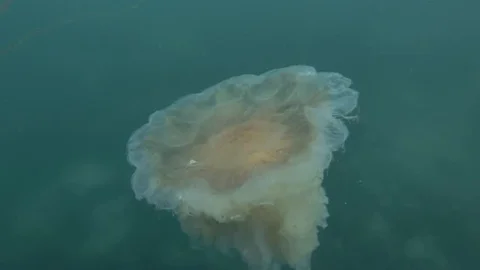The depths of the sea hide many amazing creatures, and among them occupies a special place Cyanea arctica - one of the largest jellyfish found in the cold waters of the Northern Hemisphere. She's a close relative Cyanea capillata (lion's mane jellyfish) and has similar characteristics, although its biology is still poorly understood.
This jellyfish impresses with its size and unique appearance. Its transparent body with long, thick tentacles can create a mysterious glow effect, which gives it a mystical appearance. Besides, Cyanea arctica It plays an important role in marine ecosystems, being a predator and food source for many Arctic animals.
In this article, we will look in detail at its scientific classification, appearance, habitat, life cycle, nutrition, and possible human impact.

Scientific classification
🔬 Classification of Cyanea arctica:
✔ The Kingdom: Animals (Animalia)
✔ Type: Cnidarians (Cnidaria)
✔ Class: Scyphoid (Scyphozoa)
✔ Row: Kornerotu (Rhizostomeae)
✔ Family: Cyaneidae
✔ Gender: Cyanea
✔ View: Cyanea arctica
📌 Interesting!
Gender Cyanea It includes several species of large jellyfish that live in cold waters. The most famous among them is Cyanea capillata, only Cyanea arctica it is considered even more adapted to the harsh conditions of the northern seas.
Description and appearance
💠 Main Features:
• Dome diameter: from 50 cm to 1.5 meters (sometimes more)
• Form: classic bell-shaped design with wavy edges
• Color scheme: pale yellow to dark red or purple
• Tentacles: long, can reach 20-30 meters
• Structure: the body consists of 95% water
🔹 What makes Cyanea arctica unique?
* It is there one of the largest jellyfish in the Northern Hemisphere
* Its tentacles contain toxic cnidocytes, which can paralyze the prey
* Has dense tentacle complexwhich makes it an effective hunter
📌 Interesting!
Some individuals Cyanea arctica they can reach sizes that approach the parameters of a lion's mane jellyfish (Cyanea capillata), which is the largest jellyfish in the world.

Living environment
🌍 Where does Cyanea arctica live?
• Arctic Ocean
• North Atlantic (off the coast of Greenland, Canada, Iceland, Norway and Russia)
• Barents Sea, Kara Sea
• Northern Pacific regions
🌊 Optimal living conditions:
• Water temperature: -2°C to +10°C
• Salinity: medium to high
• Depth: from surface water up to 300-500 meters
📌 Interesting!
Unlike many tropical jellyfish that live in warm waters, Cyanea arctica it is perfectly adapted to extremely cold conditions.
Life cycle
🔄 How does Cyanea arctica reproduce?
1️⃣ Sexual reproduction: Adult jellyfish release sperm and eggs into the water, where fertilization takes place.
2️⃣ Larva (planula): A small planula floats in the water column until it finds a suitable substrate.
3️⃣ Polyp: It settles on the sea floor and turns into a small polyp.
4️⃣ Strobilation: The polyp is divided into numerous small esters (young jellyfish).
5️⃣ Young jellyfish (efira): It grows into an adult.
📌 Interesting!
The development cycle of the jellyfish includes the polyp stage, which allows the species to effectively restore the population.
Nutrition and environmental role
🍽 What does Cyanea arctica eat?
• Zooplankton (crustaceans, fish larvae)
• Shrimp and other crustaceans
• Small fish
💡 How does she hunt?
Uses long, venomous tentacles to capture and paralyze prey.
📌 Interesting!
Because Cyanea arctica It is an important predator in the marine ecosystem and controls populations of small marine organisms.
Is it dangerous for humans?
⚠ Toxicity medium or high
* Burns and skin irritations
* Possible allergic reactions
* Burning sensation after contact
🚑 What should I do when contacting you?
✔ Wash the affected area with sea water
✔ Use vinegar or special gel
✔ Don't rub your skin with fresh waterbecause it can make the burn worse
📌 Interesting!
Jellyfish bites can leave long red footprintswhich may disappear within a few weeks.
Significance for science and people
🔬 Scientific research
• Study Cyanea arctica helps you understand adaptation mechanisms of cold-water jellyfish
* Her poison is being researched in medicine to develop new drugs
* It is there an indicator of climate changebecause it is sensitive to changes in ocean temperature
📌 Interesting!
In many cultures, jellyfish are used in traditional medicine and even in cooking, though Cyanea arctica unsuitable for consumption due to high toxicity.
Conclusion
Cyanea arctica – this is the great sea creature, which plays an important role in nature. It is a predator of cold ocean waters and part of the food chain. Although it can be dangerous for humans, its research opens up new opportunities for science.
🌊 Studying these jellyfish helps us better understand the world of the oceans and the adaptation of living organisms to harsh conditions.